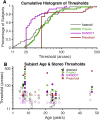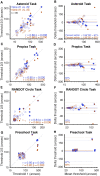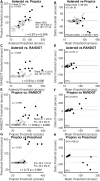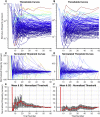Stereotest Comparison: Efficacy, Reliability, and Variability of a New Glasses-Free Stereotest
- PMID: 32879785
- PMCID: PMC7442860
- DOI: 10.1167/tvst.9.9.29
Stereotest Comparison: Efficacy, Reliability, and Variability of a New Glasses-Free Stereotest
Abstract
Purpose: To test the validity of the ASTEROID stereotest as a clinical test of depth perception by comparing it to clinical and research standard tests.
Methods: Thirty-nine subjects completed four stereotests twice: the ASTEROID test on an autostereo 3D tablet, a research standard on a VPixx PROPixx 3D projector, Randot Circles, and Randot Preschool. Within 14 days, subjects completed each test for a third time.
Results: ASTEROID stereo thresholds correlated well with research standard thresholds (r = 0.87, P < 0.001), although ASTEROID underestimated standard threshold (mean difference = 11 arcsec). ASTEROID results correlated less strongly with Randot Circles (r = 0.54, P < 0.001) and Randot Preschool (r = 0.64, P < 0.001), due to the greater measurement range of ASTEROID (1-1000 arcsec) compared to Randot Circles or Randot Preschool. Stereo threshold variability was low for all three clinical stereotests (Bland-Altman 95% limits of agreement between test and retest: ASTEROID, ±0.37; Randot Circles, ±0.24; Randot Preschool, ±0.23). ASTEROID captured the largest range of stereo in a normal population with test-retest reliability comparable to research standards (immediate r = 0.86 for ASTEROID vs. 0.90 for PROPixx; follow-up r = 0.68 for ASTEROID vs. 0.88 for PROPixx).
Conclusions: Compared to clinical and research standards for assessing depth perception, ASTEROID is highly accurate, has good test-retest reliability, and measures a wider range of stereo threshold.
Translational relevance: The ASTEROID stereotest is a better clinical tool for determining baseline stereopsis and tracking changes during treatment for amblyopia and strabismus compared to current clinical tests.
Keywords: binocular vision; depth perception; stereoacuity; stereopsis; vision tests.
Copyright 2020 The Authors.
Conflict of interest statement
Disclosure: A.G. McCaslin, None; K. Vancleef, None; L. Hubert, None; J.C.A. Read, Magic Leap (C), Huawei (F), Philosophical Transactions of Royal Society B (S); N. Port, None
Figures






References
-
- Sheedy JE, Bailey IL, Buri M, Bass E. Binocular vs. monocular task performance. Optom Vis Sci. 1986; 63: 839–846. - PubMed
-
- O'Connor AR, Birch EE, Anderson S, Draper H, FSOS Research Group. The functional significance of stereopsis. Invest Ophthalmol Vis Sci. 2010; 51: 2019–2023. - PubMed
-
- Fielder AR, Moseley MJ. Does stereopsis matter in humans? Eye. 1996; 10: 233–238. - PubMed
-
- Poggio G. The analysis of stereopsis. Annu Rev Neurosci. 1984; 7: 379–412. - PubMed
Publication types
MeSH terms
Grants and funding
LinkOut - more resources
Full Text Sources

